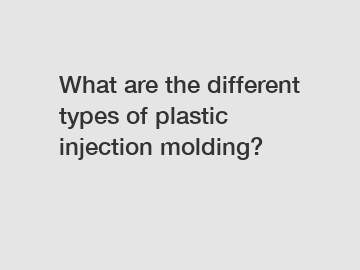What are the different types of plastic injection molding?
What are the different types of plastic injection molding?
Plastic injection molding is a widely used manufacturing process in which plastic is melted and then injected into a mold to form various products. It offers a cost-effective and efficient way to produce complex and intricate parts with high precision and accuracy. However, not all plastic injection molding techniques are the same. In this article, we will explore the different types of plastic injection molding and their applications.
1. Conventional Injection Molding:

Conventional injection molding is the most common and straightforward method used in manufacturing. It involves melting plastic pellets and injecting the molten material into a mold cavity under high pressure. Once the plastic cools and solidifies, the mold is opened, and the final product is ejected. This process is suitable for a wide range of applications, from small and intricate parts to larger components.
2. Multi-Shot Injection Molding:
Multi-shot injection molding, also known as two-shot injection molding, is a technique that produces complex parts by injecting multiple materials or colors into the same mold. This process involves two or more injections of different materials sequentially or simultaneously. It enables the production of products with multiple colors, materials, or properties in a single operation, eliminating the need for additional assembly processes.
3. Insert Molding:
Insert molding combines plastic injection molding with the insertion of pre-formed components into the mold. This technique is beneficial for adding strength, functionality, or aesthetic features to the final product. It involves placing the insert (such as metal, fabric, or another plastic part) into the mold, and then injecting molten plastic around it. This process improves efficiency and reduces the number of separate assembly steps required.
4. Overmolding:
Overmolding is a specialized type of injection molding that involves combining two or more materials to create a single, integrated product. It is commonly used to enhance product performance, improve grip or ergonomic features, or provide additional protection. Overmolding typically starts with a base material, which is then overlaid with a different material using a second injection. This technique enables the creation of complex, multi-material products in a single step.
5. Micro-Injection Molding:
Micro-injection molding is specifically designed for producing miniature and highly precise parts with tight tolerances. It uses specialized equipment and molds to inject extremely small amounts of molten plastic into intricately designed micro-cavities. This technology is widely utilized in the medical, electronics, and automotive industries, where the demand for small and intricate components is increasing.
6. Gas-Assisted Injection Molding:
Gas-assisted injection molding is a technique that uses nitrogen or another gas to hollow out or create channels within a plastic part while it is being molded. This process involves injecting the plastic into a mold cavity, followed by injecting pressurized gas into specific sections of the part. The gas pushes the molten plastic against the mold walls, creating hollow areas or channel networks. This method is particularly valuable for reducing material usage, improving part strength, and enhancing product design by implementing lightweight structures.
In conclusion, plastic injection molding offers a range of techniques that cater to different manufacturing needs. From conventional molding to specialized techniques such as multi-shot injection, insert molding, overmolding, micro-injection molding, and gas-assisted injection molding, each method provides unique advantages and benefits. By understanding the different types of plastic injection molding, manufacturers can optimize their production processes and create high-quality products with precision and efficiency. So, whether you require small, intricate components or complex multi-material products, plastic injection molding has the solution for you.
Are you interested in learning more about rapid tooling suppliers, china airplane parts rapid mold tools company, wintech limited? Contact us today to secure an expert consultation!
173
0
0


Comments
All Comments (0)